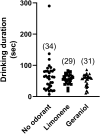Impact of odorants on perception of sweetness by honey bees
- PMID: 38150461
- PMCID: PMC10752549
- DOI: 10.1371/journal.pone.0290129
Impact of odorants on perception of sweetness by honey bees
Abstract
Organic volatiles produced by fruits can result in overestimation of sweetness by humans, but it is unknown if a comparable phenomenon occurs in other species. Honey bees collect nectar of varying sweetness at different flowering plants. Bees discriminate sugar concentration and generally prefer higher concentrations; they encounter floral volatiles as they collect nectar, suggesting that they, like humans, could be susceptible to sweetness enhancement by odorant. In this study, limonene, linalool, geraniol, and 6-methyl-5-hepten-2-ol were tested for their ability to alter behaviors related to perception of sweetness by honey bees. Honey bees were tested in the laboratory using proboscis extension response-based assays and in the field using feeder-based assays. In the laboratory assays, 6-methyl-5-hepten-2-ol and geraniol, but neither linalool nor limonene, significantly increased responses to low concentrations of sucrose compared with no odorant conditions in 15-day and 25-day-old adult worker honey bees, but not in 35-day-old bees. Limonene reduced responding in 15-day-old bees, but not in the older bees. There was no odorant-based difference in performance in field assays comparing geraniol and limonene with a no odorant control. The interaction of the tested plant volatiles with sucrose concentration revealed in laboratory testing is therefore unlikely to be a major determinant of nectar choice by honey bees foraging under natural conditions. Because geraniol is a component of honey bee Nasonov gland pheromone as well as a floral volatile, its impact on responses in the laboratory may reflect conveyance of different information than the other odorants tested.
Copyright: © 2023 Pel et al. This is an open access article distributed under the terms of the Creative Commons Attribution License, which permits unrestricted use, distribution, and reproduction in any medium, provided the original author and source are credited.
Conflict of interest statement
The authors have declared that no competing interests exist.
Figures




Similar articles
-
Pollen and yeast change nectar aroma and nutritional content alone and together, but honey bee foraging reflects only the avoidance of yeast.Environ Microbiol. 2021 Aug;23(8):4141-4150. doi: 10.1111/1462-2920.15528. Epub 2021 Apr 25. Environ Microbiol. 2021. PMID: 33876542
-
Honeybees generalize among pollen scents from plants flowering in the same seasonal period.J Exp Biol. 2019 Nov 8;222(Pt 21):jeb201335. doi: 10.1242/jeb.201335. J Exp Biol. 2019. PMID: 31611291
-
Variation in highbush blueberry floral volatile profiles as a function of pollination status, cultivar, time of day and flower part: implications for flower visitation by bees.Ann Bot. 2011 Jun;107(8):1377-90. doi: 10.1093/aob/mcr077. Epub 2011 Apr 15. Ann Bot. 2011. PMID: 21498566 Free PMC article.
-
Temporal model of fluid-feeding mechanisms in a long proboscid orchid bee compared to the short proboscid honey bee.J Theor Biol. 2020 Jan 7;484:110017. doi: 10.1016/j.jtbi.2019.110017. Epub 2019 Sep 19. J Theor Biol. 2020. PMID: 31542476 Review.
-
Nutritional Physiology and Ecology of Honey Bees.Annu Rev Entomol. 2018 Jan 7;63:327-344. doi: 10.1146/annurev-ento-020117-043423. Epub 2017 Oct 13. Annu Rev Entomol. 2018. PMID: 29029590 Review.
Cited by
-
Subtle effects of acetone and amitraz on sucrose sensitivity and recall in honey bees.Sci Rep. 2025 Jul 1;15(1):20867. doi: 10.1038/s41598-025-06466-z. Sci Rep. 2025. PMID: 40594973 Free PMC article.
References
-
- U.S. Department of Agriculture, Agricultural Research Service. FoodData Central, 2019. https://fdc.nal.usda.gov.
-
- Gilbert JL, Guthart MJ, Gezan SA, Pisaroglo de Carvalho M, Schwieterman ML, Colquhoun TA, et al.. Identifying breeding priorities for blueberry flavor using biochemical, sensory, and genotype by environment analyses. PLoS ONE. 2015;10(9): e0138494. doi: 10.1371/journal.pone.0138494 - DOI - PMC - PubMed
MeSH terms
Substances
LinkOut - more resources
Full Text Sources

